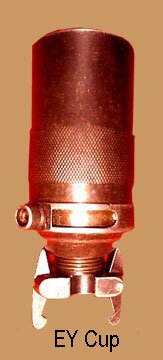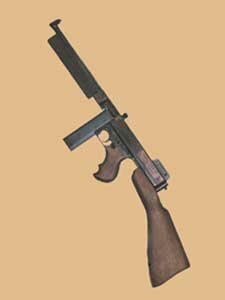Standard Rifle, The Lee-Enfield
During the desert campaign both rifles were encountered, however photographic evidence suggest the SMLE MKIII was the weapon most often used. This is especially the case among the LRDG where a large contingent of forces came from New Zealand, and were more apt to be armed with the ANZAC weapon of choice.
SMLE. Mark III Short Magazine Lee Enfield
The Mk III SMLE had been combat tested in the trenches of World War I and was found to be accurate as well as fast firing for a bolt action rifle. What aided in the rapid firing of both models was the rear locking bolt which could activated with the less hand movement, allowing the shooter to disengage and re-engage the bolt faster and with less head movement.
The SMLE mounted Mk. I sword bayonet. (see Knives). The rifle also had a graduated sight located in front of the bolt assembly. The rifle was introduced in 1907 and modified in 1915 and 1926. Plans were put in place for a replacement rifle for the MkIII in 1930 with the No. 4 rifle first being issued in 1939. Full production of the No.4 was not realized until 1942. The No. 4 Rifles was never adopted by ANZAC forces.

- Length: 44.5 Inches
- Barrel: 25.19 inches
- Weight -No. 1 Mk III: 8 pounds 2 ounces
- Caliber: .303 rimmed.
- Magazine capacity: 10 rounds
- Muzzle velocity: 744 mps (2,441 fps)
- Effective range: 503 m (550 yds)
- Maximum range 1829 m ( 2,000 yds)
- Action: Rear locking curved bolt
Lee-Enfield No 4 Mark I 1939 Model.
The No. 4 Rifle was similar in many respects to the SMLE, however it weighed slightly more. It also used a different bayonet lug, designed for use with the spike bayonet (see Knives). A more simplified rear sight located above the bolt assembly was now used. The overall manufacturing of the No. 4 Rifle was less expensive however the rifle was slightly heavier. By 1942, production of the No.4 Rifle was in full swing with large qualities being made in Canada. This led to the rifle sometimes being called the Canadian Rifle.

- Length: 113 cm (44.5 Inches)
- Barrel: 65.5 cm (25.19 inches)
- Weight - No. 4 Mk I or MkII : 8 pounds 13 ounces
- Caliber: .303 rimmed.
- Magazine capacity: 10 rounds
- Muzzle velocity: 744 mps (2,441 fps)
- Effective range: 503 m (550 yds)
- Maximum range 1829 m ( 2,000 yds)
- Action: Rear locking curved bolt
EY Rifle, The Grenade Launcher
Conflicting reports suggest that the EY rifle was an SMLE or No. 4 rifle that was no longer accurate enough for actual service and were fitted with a cup for use of launching the Mills Bomb (No. 36 Hand Grenade). If this is the case, the barrel was reinforced by wrapping wire around the wooden stock to prevent the wood from shattering when the grenade was launched.
In any case, the EY rifle is simply an SMLE or Enfield No.4 converted with a cup and a special plate to throw the Mills grenade. In order to do this, a special blank cartridge is fired which cause the base plate to launch the grenade.


Rifle no.3 Mk. II (T)
( P14MkI*(T) – The American Enfield 14 Rifle Sniper’s Rifle)
While considered obsolete and primarily used to arm the home defense forces, the Pattern 14 rifle was still the primary sniper Rifle for the British Army until 1943, when a suitable variant the Lee No. 4 Mk1 was introduced. Known as the Pattern 14 or American Enfield, the rifle was re-designated Rifle No3 in 1932. Weapons manufactured by the Winchester Small Arms Factory in the United States were considered the most accurate and after field testing the most accurate of these weapons were used for sniper duty. Some were equipped with an Aldus telescopic sight and these had (T) added to their nomenclature.
The rifle began as the Pattern 13 and was an attempt to create a smaller caliber service rifle that would fire a .276 caliber bullet. The Pattern 13 was approved for further development; however, with the outbreak of WWI, the British rushed it into production. Knowing a different caliber bullet would be a logistics nightmare, the British had the Pattern 13 re-chambered to fire the .303 rimmed cartridge already in use. The rifle was renamed the Pattern 14 (or M1917 in American use) and were made in Canada and the United States. The rifles were issued to British units to supplement their stock of SMLEs rifles.
During World War I it was determined that the Pattern 14 was more accurate than the SMLE at long ranges (both scoped and un-scoped) and became relegated to sniper duty. In the years between the wars little attention was spent developing a new sniper’s rifle within Britain* and with the outbreak of the World War II, Britain once again turned to the P14, now known as Rifle No3.. It was not until 1943 that it was replaced by a sniper’s rifle based on the No.4 Lee. However the Rifle no. 3 continued in service until the end of the war.
* Australia did develop a sniper’s version of an SMLE but it was not the principle snipers rifle in the early years among most Commonwealth forces.

Rifle no.3 Mk. II (T) -- P14MkI*(T) – The American Enfield 14 Rifle Sniper’s Rifle.
Specifications
- Weight: 9 lb 6 oz (4.25 kg) unloaded
- Length: 46 ¼ in (1175 mm)
- Barrel length: 26 in (660 mm)
- Caliber: .303 rimmed
- Action: Modified Mauser turn bolt-action
- Rate of fire: NA
- Muzzle velocity: 2380 fps
- Effective range: 800+ meters
- Magazine capacity: 5 round

Close up of aldus sight and modified Mauser bolt of the No.3 Rifle.
The Thompson Submachine Gun, The Tommy Gun

Thompson M1928
- Length: 34 1/2 inches
- Barrel Length:- 10 1/2 inches
- Weight: 11 pounds
- Caliber: .45 ACP
- rate of fire: 600 to 725 RPM
- muzzle velocity: 928 FPS
- Action: Semi / full auto
- Method of fire: Delayed blowback
- Magazine: 50 rd drum / 20 rd box

M1928 with straight foregrip and 20round magazine
The M1928 Thompson submachine gun (SMG) was an American weapon that was made possible via lend-lease. At the outbreak of the war Great Britain only had the Lanchester submachine gun which was a copy of the German MP28. It was expensive to produce and rather heavy. (As was the early Thompsons!) In any even,t Churchill quickly saw the need for SMGs after having seen how useful the German MP40s were and he requested as many Thompsons as he could get. The Thompsons or Tommy Guns were immediately issued to Commando raiding parties. The Commandos were impressed with the Tommy Gun and its massive 45 ACP bullet.
Later Tommy guns were issued to British NCO's and were used throughout the British Army until sufficient number of Sten guns became available and the Thompson was phased out
The Tommy Guns also found their way into the LRDG. The version shown here is the M1928 with vertical front grip and the drum magazine. This model could also use a 20 round and later 30 box magazine*. The vertical grip was later replaced with the straight horizontal grip. The later M1 Thompson had a permanent stock, was full automatic only, and used a the simple blowback method for fire. The early M1928 shoulder stock could be removed. Both version were used by the LRDG.
* The drum magazine gave a good reservoir of ammunition but was heavy.The drum magazine of the M1928 was serial numbered and matched to individual weapons. The was also slow to reload, especially in combat conditions.
The 30 round box magazine did not become available in March,1942, with the introduction of the M1 Thompson. (some sources say the M1 did not reach the front lines until 1943.) In either case, the M1 was not used as widely by the British in the Desert as the M1928.
Outwardly, the easiest way to spot an M1 versus an M1928 is the location of the bolt charger. If it is on top of the receiver, it is an M1928, on the right side an M1. The more complicated sights are another dead giveaway.
Read more about weapons:
